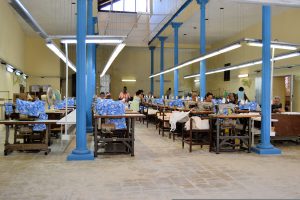Get ready, get set, SHOP! That’s what this time of year can feel like, right? We’re bombarded with ads for sales, and everywhere we look there’s temptation to buy. But it’s not just this time of year that companies are competing for our attention and our dollars. Have you noticed, for example, that when it comes to the fashion industry, trend cycles are speeding up, and we’re constantly being shown new, cheap items that we can purchase – and then dispose of next season?
This phenomenon of super cheap, lower quality, high turnaround clothing is known as “fast fashion,” and many are arguing that it’s not just changing the way we consume, but also having a big impact on the environment, among other issues. So if you’re looking to gift some clothes, shoes, or accessories this holiday season (or are looking for those perfect party clothes for yourself), should you steer clear of the fast fashion behemoth?
Fast Fashion by the Numbers
So what exactly do we mean by fast fashion? It’s not really a category of clothing, rather it’s a business model, one that relies on mass-producing cheaply made, and cheaply priced, “of-the-moment” items based on ideas from fashion shows or celebrity culture. These items aren’t built to last: it’s expected that consumers will often only use them for a season, and then hopefully move on to the next trend. 
Generally, companies that produce fast fashion use cheap materials and cheap labor to churn out clothing collections at a rapid pace – it can often feel like brick-and-mortar stores have new items arriving overnight, and online shops have pages and pages of new items to scroll through every minute.
While we can argue that one of the big problems with fast fashion is how it has changed our brains as consumers, two of the main issues that many experts are more concerned about are the “cheap materials” and “cheap labor” that go into keeping the fast fashion industry churning out items. But before we look more closely at those major issues, let’s get an overview of what’s going on in this multi-billion industry with some eye-opening statistics:
- Since the year 2000, clothing sales have doubled from 100 to 200 billion units a year.
- In the same time period, the average number of times an item was worn decreased by 36% overall.
- It is estimated that around the world, around 107 billion units of apparel and 14.5 billion pairs of shoes were purchased in 2016.
- Garments given up after a short period of time and thrown out (by both consumers and retailers), instead of recycled, combine to produce a massive amount of financial waste, estimated at around $500 billion every year.
- We discard 92 million tons of clothing-related waste each year, which breaks down to a garbage truck of clothing either being incinerated or sent to a landfill every second, and is enough to fill one and a half Empire State Buildings every day.
- In the 1950s, if a woman wanted to purchase a ready-made dress, she could spend about $9 (or $72 in today’s dollars) to order an item from a Sears catalog. Today, a shopper could walk into Forever 21 and buy a simple dress for about $12.
- Some fast fashion chains, like Fashion Nova, say that they launch around 600 to 900 new styles every week.
- People tend to prioritize ease of purchase and price of an item over sustainability, according to a 2018 report that surveyed nearly 700 shoppers ages 18 to 37.
- “One in three young women, the biggest segment of consumers, consider garments worn once or twice to be old,” according to The Guardian.
- The fashion industry churns out a staggering 80 billion garments a year – that’s over 10 for every person on earth.
Those dizzying numbers show the cycle of how fast fashion is creating our consumer demand and feeding it, with some serious consequences. So let’s take a look at some of those consequences.
The Environmental Impact of Fast Fashion
It’s amazing to think that, according to the House of Commons Environmental Audit Committee in 2019, “Clothing production is the third biggest manufacturing industry after the automotive and technology industries. Textile production contributes more to climate change than international aviation and shipping combined.”
And, while the insane amount of clothing that is thrown away and ends up incinerated or in landfills that we pointed out above is a huge problem, that’s just the beginning. Some of the major environmental concerns about fast fashion include:
The materials used
So many fast fashion items are made with synthetic fabrics like polyester. The problem with these fabrics? The microfibers from synthetic fabrics get released into our waterways, and then into our rivers, lakes, and oceans every time they are washed in domestic washing machines. The small size of the microfibers means they are easily consumed by fish and other wildlife. And the fashion industry accounts for 20 to 35% of microplastic flows into the ocean!
Not only that, but nearly 70 million barrels of oil are used each year to make the world’s polyester fiber, and it takes more than 200 years to decompose. But the cotton used by this industry is not really all that much of a better alternative: over one quarter of the world’s pesticides are being used to grow conventional cotton.
The impact on water supplies
Speaking of affecting water, fast fashion also impacts our water supplies in other ways. Not only does the fast fashion industry consume 1.5 trillion tons of water per year, but the dyeing of textiles in the production of apparel is known to be the second biggest polluter of water worldwide, second only to agriculture. Developing countries often bear the burden of this impact, and end up with carcinogens or other toxins (like lead, mercury, and arsenic) in their water supplies.
The waste produced
We already pointed out a few statistics on the waste that the fast fashion industry produces, but it’s worth saying it again. After all, 3 out of 5 fast fashion items will end up in a landfill! And the industry isn’t doing much to help: less than 11% of brands are implementing recycling strategies for their items.
The carbon emissions
How much of an impact on global emissions could some tee shirts and dresses have? An eye-popping amount. In fact, the fashion industry is responsible for a full 8% of the world’s carbon emissions. Everything along the fast fashion industry supply chain contributes, including things like pumping water to irrigate crops (like cotton), the harvesting machinery, general transport of items, and the use of oil-based pesticides. And just think about this: the production of polyester textiles alone emits about 706 million tons of greenhouse gasses a year.
All of the above obviously has a huge impact on people, but fast fashion is also problematic for people in other ways, so let’s look at the human impact of fast fashion.
The Human Impact of Fast Fashion
All of those clothes need to be produced, right? And while it’s easy to think that they’re being mass-produced by machines, that just isn’t true. Workers need to toil to churn out the never ending supply of clothing offered by fast fashion brands, and they are often doing so in inhumane conditions.
Consider this: there are approximately 40 million garment workers in the world today (or up to 80 million in the whole supply chain), many of whom do not have rights or protections. They are some of the lowest paid workers in the world. In fact, only 2% of them earn a living wage – two percent!
And roughly 85% of all garment workers are women. Women especially are being exploited, and often pay a terrible price for their work. Remember the building collapse in the Rana Plaza clothing manufacturing complex in Dhaka in 2013? Over 1,100 workers were killed and over 2,500 injured, most of whom were women.
Why It’s So Hard to Quit Fast Fashion, and What We Can Do
These are some extremely dire facts and figures, we know, and all of it can feel overwhelming. It can be hard to take it all in, and hard to actually feel like things can change. And we’ve become very accustomed to fast fashion since its meteoric rise in the early 2000s, as we’ve gone more towards being a culture of disposable commodities. As we pointed out earlier, the fast fashion industry has very cleverly latched onto a cycle of creating an insatiable demand for newness and consumption, and feeding that desire.
And think about this: what else has had a meteoric rise since the early 2000s? Social media. The target audience of fast fashion often lives their lives online, and are very aware of what it means to be “seen” in a variety of senses. Many feel pressure to look not only constantly on trend, but also “new.” In fact, according to a 2017 survey commissioned by the London sustainability firm Hubbub, 41% of 18- to 25-year-olds feel pressured to wear a different outfit every time they go out.
So yeah, we like shopping, we like endless novelty, and we like being able to express ourselves through fashion the way that people with more money and influence can – and we’re often willing to overlook the problems with the fast fashion industry that allows us to do this. But if you’re interested in reducing your reliance on this industry, consider:
- Being aware – The first step towards knowing how your shopping habits affect the world is being aware of the practices of the companies you buy from. They are often not very transparent, unfortunately, but that’s probably a sign that there’s a lot they need to change. If a company doesn’t meet your expectations, vote with your dollars and shop elsewhere.
- Buy less – Sometimes easier said than done! But try to move towards buying what you need, and mix and match the pieces you have to create new styles. It’s ok to love the clothes you have, and to mend them if needed!
- Shop secondhand – One of the best ways to reduce your clothing footprint is to get thrifting! You’ll be giving clothes that might otherwise be tossed out a new life, AND you’ll be getting some unique pieces that will really help you show off your style.
- Buy sustainable – Look for brands or small companies that use sustainable materials and a sustainable supply chain to make their clothing. The bonus is that these clothes tend to be higher quality and last longer, so everyone wins.

- Donate – Don’t throw out your old clothes! Find places and people you can donate to, whether it’s an effort to help out people in your own neighborhood, or a thrift store. Just make sure you know what the shop does with clothing they can’t sell – many thrift stores don’t recycle, and your clothing will just end up getting scrapped anyway.
There’s often a surprising amount we don’t know about the things we buy. But, hey, they say that knowing is half the battle! And while one person can’t change a whole culture – like the culture of fast fashion – overnight, we can be more aware of the impact of our choices, and try to hold companies accountable for their practices. And it can be fun to support that person designing sustainable clothes, or head out for a day of thrifting (our especial favorite!), so there are ways to enjoy expressing yourself with your style that maybe feel a little less, well, fraught. So let us know: how do you feel about fast fashion? And are people starting to feel over it, and ready for a more sustainable model? And what’s better: trying to force fast fashion brands to change their ways, or working to get rid of the whole industry and culture altogether? We want to hear from you!
Co-written by Joanna Bowling
